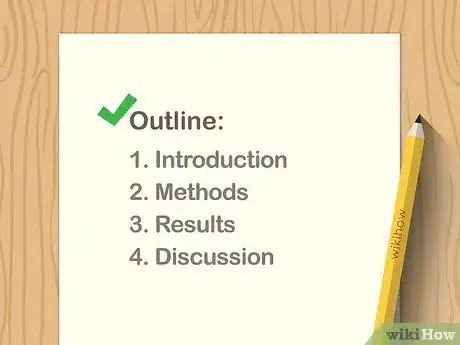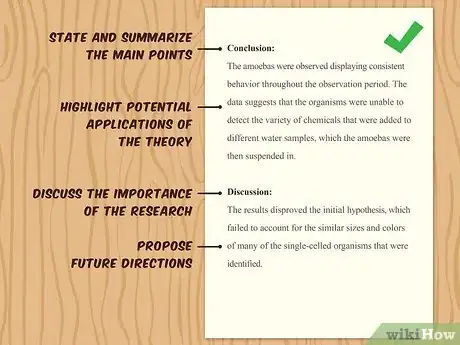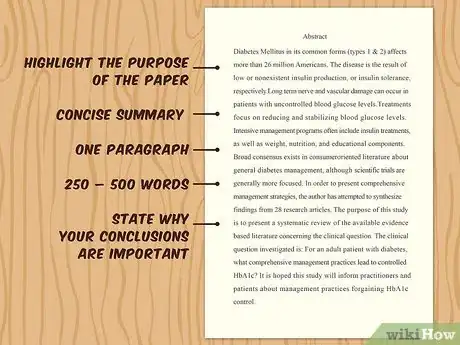This article was co-authored by Chris M. Matsko, MD. Dr. Chris M. Matsko is a retired physician based in Pittsburgh, Pennsylvania. With over 25 years of medical research experience, Dr. Matsko was awarded the Pittsburgh Cornell University Leadership Award for Excellence. He holds a BS in Nutritional Science from Cornell University and an MD from the Temple University School of Medicine in 2007. Dr. Matsko earned a Research Writing Certification from the American Medical Writers Association (AMWA) in 2016 and a Medical Writing & Editing Certification from the University of Chicago in 2017.
wikiHow marks an article as reader-approved once it receives enough positive feedback. In this case, 90% of readers who voted found the article helpful, earning it our reader-approved status.
This article has been viewed 192,140 times.
Writing a medical research paper is similar to writing other research papers in that you want to use reliable sources, write in a clear and organized style, and offer a strong argument for all conclusions you present. In some cases the research you discuss will be data you have actually collected to answer your research questions. Understanding proper formatting, citations, and style will help you write and informative and respected paper.
Steps
Researching Your Paper
-
1Decide on a topic. You probably have a general idea of what you want to write about. Narrow that down to a specific focus by reading up on the current research. Find background information about your topic and identify potential sources that you can use. Ask your professor for feedback and suggestions.
- Pick something that really interests you to make the research more fun.
- Choose a topic that has unanswered questions and propose solutions.
-
2Determine what kind of research paper you are going to write. The format of your paper depends heavily on what type of paper you want to write. It also affects the type of research you use.
- Quantitative studies consist of original research performed by the writer. These research papers will need to include sections like Hypothesis (or Research Question), Previous Findings, Method, Limitations, Results, Discussion, and Application.
- Synthesis papers review the research already published and analyze it. They find weaknesses and strengths in the research, apply it to a specific situation, and then indicate a direction for future research.
Advertisement -
3Research your topic thoroughly. Interview individuals who have special knowledge or experience with your issue. Find reliable sources to support your ideas. Your research paper is only as credible as the sources you use. Academic journals, databases, and books are a great source of information.
- Keep track of your sources. Write down all publication information necessary for citation: author, title of article, title of book or journal, publisher, edition, date published, volume number, issue number, page number, and anything else pertaining to your source. A program like Endnote can help you keep track of your sources.
- Take detailed notes as you read. Paraphrase information in your own words or if you copy directly from the article or book, indicate that these are direct quotes by using quotation marks to prevent plagiarism.
- Be sure to keep all of your notes with the correct source.
- Your professor and librarians can also help you find good resources.
-
4Organize your notes. Sorting your notes by topic will make it easier to find the information you need while writing the actual paper. Using digitized notes allows you to easily search for specific information and quickly reorganize reference information.
- Keep all of your notes in a physical folder or in a digitized form on the computer.
- Start to form the basic outline of your paper using the notes you have collected.
Writing Your Paper
-
1Outline your paper. Organize it in a way that makes sense and is easy to follow. Determine what information fits best under each heading or section and integrate your sources as you go. Starting with an outline is also an easy way to get started with the writing.
- Start with bullet points and then add in notes you've taken from references that support your ideas.[1]
- A common way to format research papers is to follow the IMRAD format. This dictates the structure of your paper in the following order: Introduction, Methods, Results, and Discussion.[2]
- The outline is just the basic structure of your paper. Don't worry if you have to rearrange a few times to get it right.
- Ask others to look over your outline and get feedback on the organization.
- Know the audience you are writing for and adjust your style accordingly.[3]
-
2Know the required format. Look up the guidelines and formatting requirements before you begin. Each journal or grant writing institution has different format requirements as to length and style. The length of your paper will probably be pre-determined, but aim for 10 – 20 pages unless instructed differently.
- Use a standard font type and size, such as Times New Roman 12 point font.
- Double-space your paper.
- If necessary, create a cover page. Most schools require a cover page of some sort. Include your main title, running title (often a shortened version of your main title), author's name, course name, and semester.
-
3Compile your results. Divide the paper into logical sections determined by the type of paper you are writing. If it is a quantitative study, it needs to include the sections mentioned above (i.e., Hypothesis, Previous Findings, etc.). If it is a qualitative study, organize your paper into main points that make sense and progress naturally.
- Break up information into sections and subsections and address one main point per section.
- Include any figures or data tables that support your main ideas.
- For a quantitative study, state the methods used to obtain results.
-
4Write the conclusion and discussion. Tell the reader what you have found, why it is relevant to the field, and what future studies could be done to further this research. Avoid repeating information that has been stated elsewhere in the paper.
- Clearly state and summarize the main points of your research paper.
- Discuss how this research contributes to the field and why it is important.[4]
- Highlight potential applications of the theory if appropriate.
- Propose future directions that build upon the research you have presented.[5]
- Keep the introduction and discussion short, and spend more time explaining the methods and results.[6]
-
5Write the introduction. Write the introduction after the bulk of your paper is complete so you know exactly what is necessary to include for the reader to understand your paper. Introduce your reader to the topic of your research paper. Provide basic background information, why you are writing this paper, and what they can expect as a result of reading it.
- State why the problem is important to address.
- Discuss what is currently known and what is lacking in the field.
- State the objective of your paper.
- Keep the introduction short.
-
6Write the abstract. An abstract summarizes the article by highlighting the main points and allows the reader to know what information your paper contains. Write the abstract last after you have finished the paper so you can properly summarize everything you have written about.[7]
- Highlight the purpose of the paper and the main conclusions.
- State why your conclusions are important.
- Be concise in your summary of the paper.
- Show that you have a solid study design and a high-quality data set.
- Abstracts are usually one paragraph and between 250 – 500 words.
-
7Cite while you write. Citing sources is an absolute must to avoid plagiarism and give others credit for their ideas. Adding citations while you write the paper is much easier than digging through your sources at the end to determine where an idea came from.
- Unless otherwise directed, use the American Medical Association (AMA) style guide to properly format citations.
- Add citations at end of a sentence to indicate that you are using someone else's idea. Use these throughout your research paper as needed. They include the author's last name, year of publication, and page number.
- Compile your reference list and add it to the end of your paper.
- Use a citation program if you have access to one to simplify the process.
-
8Edit your research paper. You want to make sure that your paper is logically organized and flows well. It's also important to turn in a final draft free of any spelling and/or grammatical errors.
- Continually revise your paper to make sure it is structured in a logical way.
- Proofread your paper for spelling and grammatical errors.
- Make sure you are following the proper formatting guidelines provided for the paper.
- Have others read your paper to proofread and check for clarity. Revise as needed.
Expert Q&A
Did you know you can get expert answers for this article?
Unlock expert answers by supporting wikiHow
-
QuestionCan you provide some sample papers to use as a guide?
 Chris M. Matsko, MDDr. Chris M. Matsko is a retired physician based in Pittsburgh, Pennsylvania. With over 25 years of medical research experience, Dr. Matsko was awarded the Pittsburgh Cornell University Leadership Award for Excellence. He holds a BS in Nutritional Science from Cornell University and an MD from the Temple University School of Medicine in 2007. Dr. Matsko earned a Research Writing Certification from the American Medical Writers Association (AMWA) in 2016 and a Medical Writing & Editing Certification from the University of Chicago in 2017.
Chris M. Matsko, MDDr. Chris M. Matsko is a retired physician based in Pittsburgh, Pennsylvania. With over 25 years of medical research experience, Dr. Matsko was awarded the Pittsburgh Cornell University Leadership Award for Excellence. He holds a BS in Nutritional Science from Cornell University and an MD from the Temple University School of Medicine in 2007. Dr. Matsko earned a Research Writing Certification from the American Medical Writers Association (AMWA) in 2016 and a Medical Writing & Editing Certification from the University of Chicago in 2017.
Family Medicine Physician Here is a sample paper you can look at: http://www.jbc.org/content/274/43/30580.full.pdf
Here is a sample paper you can look at: http://www.jbc.org/content/274/43/30580.full.pdf
Warnings
- Do not plagiarize. Plagiarism is using someone else's work, words, or ideas and presenting them as your own. It is important to cite all sources in your research paper, both through internal citations and on your reference page.⧼thumbs_response⧽
References
- ↑ http://www.ncbi.nlm.nih.gov/pmc/articles/PMC3178846/
- ↑ http://owl.excelsior.edu/research-and-citations/outlining/outlining-imrad/
- ↑ http://china.elsevier.com/ElsevierDNN/Portals/7/How%20to%20write%20a%20world-class%20paper.pdf
- ↑ http://china.elsevier.com/ElsevierDNN/Portals/7/How%20to%20write%20a%20world-class%20paper.pdf
- ↑ http://intqhc.oxfordjournals.org/content/16/3/191
- ↑ https://www.councilscienceeditors.org/wp-content/uploads/v23n2p039-044.pdf
- ↑ http://www.ruf.rice.edu/~bioslabs/tools/report/reportform.html#form
About This Article
To write a medical research paper, research your topic thoroughly and compile your data. Next, organize your notes and create a strong outline that breaks up the information into sections and subsections, addressing one main point per section. Write the results and discussion sections first to go over your findings, then write the introduction to state your objective and provide background information. Finally, write the abstract, which concisely summarizes the article by highlighting the main points. For tips on formatting and using citations, read on!











































































